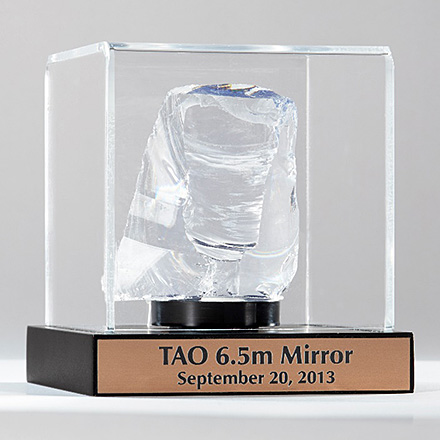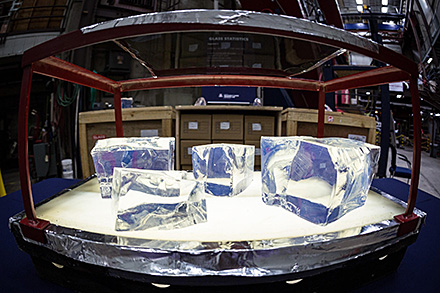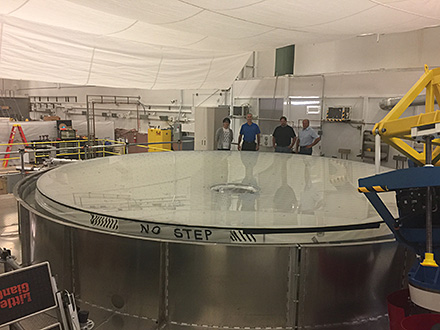
|
TAO Project |
|
The TAO project

|
The Domestic Manufacturer Behind the TAO 6.5m Telescope: OHARA INC.Human beings have been making efforts to increase the size of telescopes in their never-ending quest to observe more distant and fainter objects in greater detail. However, due to the fact that the telescope must be pointed to any direction in the sky, the weight of the telescope itself is an obstacle to enlargement. In particular, a large primary mirror to first collect light from the universe is distorted by gravity, making it difficult to obtain sharp images of celestial objects. In addition, it is also difficult to move such a heavy equipment accurately. In the 1980s, Dr. Roger Angel of the University of Arizona in the USA found that a honeycomb structure with a hollowed-out (like bees' nest) backside of a mirror was suitable for making large, lightweight mirrors. He also found that borosilicate glass was a suitable material for the honeycomb mirrors. Dr. Angel began his experiments by constructing a small mirror in the backyard of the University of Arizona campus. The experimental results were encouraging. In the 1990s, he finally succeeded in building a giant honeycomb mirror with a diameter of 6.5 meters, and completed the MMT telescope at the top of Mount Hopkins in Arizona, USA. The borosilicate glass used for this giant honeycomb mirror is called E6, manufactured by OHARA INC. in Japan (Fig.1). Borosilicate glass is now widely known as one of the best materials for mirrors of large telescopes because of its various advantages, such as relatively low coefficient of thermal expansion, uniform molding at relatively low temperatures, relatively low cost, and resistance to maintenance solvents required for long-term use. After experimenting with various types of borosilicate glass, Dr. Angel and his colleagues decided that OHARA’s E6 glass was the best material for large telescope mirrors, and have produced many mirrors since then. The honeycomb structure realized with borosilicate glass is lightweight and has a large surface area. Then, temperature of the mirror quickly adjusts to the outside temperature so that the mirror temperature can be adjusted according to the rapid decrease of ambienttemperature after sunset, and sharp images of celestial objects can be obtained.1)
Later, the University of Arizona established the Steward Observatory Mirror Lab (now called the Richard F. Caris Mirror Lab), a facility for the development and fabrication of large mirrors, and became the world leader in the fabrication of honeycomb mirrors for large telescopes. The Mirror Lab have fabricated many 6.5m and 8.4m mirrors. For example, the Mirror Lab's mirrors are used for the Large Binocular Telescope (LBT) in the USA, Magellan telescopes in Chile, and so on. The Rubin Observatory Simonyi Survey Telescope (8.4m mirror) and the Giant Magellan Telescope (GMT, "25m mirror" by combining seven 8.4m mirrors) will be completed and their observation operation will start in 2023 and 2029, respectively. Materials of all these mirrors are OHARA's E6 glass. The mirror of the TAO 6.5m telescope is also a honeycomb mirror manufactured in the Mirror Lab using OHARA's E6 glass. We decided to use a honeycomb-shaped 6.5m mirror by the University of Arizona to take a full advantage of the highest altitude of the observatory (5,640m above the sea level, i.e., the least atmosphere above the ground-based telescope) and to make easy regular operation at such a high site. In January 2020, the performance test of the mirror was completed. As of February 2022, the mirror is ready for shipping to the telescope site and currently stored at the University of Arizona. During the University of Arizona researchers' visit to the University of Tokyo in 2014, a visit to OHARA was realized at their strong urging. The University of Arizona researchers expressed their huge respect for OHARA's support and exchanged various opinions with OHARA personnel. We are proud that the mirrors of the world's most advanced telescopes, including those in the USA, are made of glass fabricated by OHARA INC. in Japan, and at the same time, we are delighted that the TAO 6.5m telescope will be added to the history of the world's telescopes together with OHARA INC., which the Mirror Lab loves.
1) If there is a temperature difference between the mirror surface and the air, air fluctuation is created, resulting in a blurred celestial image, and the performance of the telescope is degraded.
Copyright(c) 2024 TAO Project, Institute of Astronomy, Graduate School of Science, University of Tokyo
|



